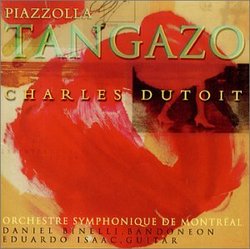| All Artists: Charles Dutoit, Orchestre Symphonique De Montreal, Daniel Binelli, Eduardo Isaac, Louise Pellerin Title: Piazzolla: Tangazo Members Wishing: 0 Total Copies: 0 Label: Decca Original Release Date: 1/1/2001 Re-Release Date: 11/13/2001 Genres: Dance & Electronic, International Music, Jazz, Classical, Latin Music Styles: Latin Music, Tango, Latin Jazz, Chamber Music, Forms & Genres, Concertos, Historical Periods, Modern, 20th, & 21st Century, Symphonies Number of Discs: 1 SwapaCD Credits: 1 Other Editions: Super Artists on Super Audio, Vol. 2 [Hybrid SACD] UPC: 028946852828 |
Search - Charles Dutoit, Orchestre Symphonique De Montreal, Daniel Binelli :: Piazzolla: Tangazo
 | Charles Dutoit, Orchestre Symphonique De Montreal, Daniel Binelli Piazzolla: Tangazo Genres: Dance & Electronic, International Music, Jazz, Classical, Latin Music
|
Larger Image |
CD Details |
CD ReviewsMy search for Oblivion has a happy ending. Bob Zeidler | Charlton, MA United States | 06/02/2002 (5 out of 5 stars) "Recently, I attended a concert by a chamber orchestra on tour. The printed program for the concert was largely "standard fare." There were then two encores, one of which I knew had to have been the work of Astor Piazzolla, but a Piazzolla work I hadn't recalled ever hearing. (I can't claim to have a particularly large library of Piazzolla works, but the library had already included the more popular successes by the Kronos Quartet, Gidon Kremer, Daniel Barenboim and Yo-Yo Ma.) Summoning up my courage after the concert, I went backstage to ask one of the musicians what the Piazzolla encore was. The answer was "Oblivion" (and I was, fortunately, not embarrassed by having to ask who the composer was; the absence of the near-obligatory bandoneon in this chamber orchestra did not "throw me off-track"). Well, I just had to have a recording of "Oblivion" after hearing that encore. And an Amazon search led me to this superb recording by Charles Dutoit and the Montréal Symphony Orchestra, with "Oblivion" smack-dab in the middle of things (track 6 of 11); a centerpiece of sorts. If there is a sadder, more wistful and languorous work than this brief piece, I have yet to hear it. (Some of the piano works of Eric Satie may come close, but they still miss by the proverbial mile.) "Oblivion" has a way of insinuating itself under your skin, and one wants to hear it again and again; I listened to it three times in succession before I played the entire CD. Scored (by Piazzolla) for strings, oboe solo and bandoneon obbligato, it is simply magical. And quite addictive. While the attention paid to Piazzolla always seems to be in the context of his tangos, he was nonetheless a trained serious composer, studying with Alberto Ginastera and Nadia Boulanger. The Ginastera connection comes through in a few of the selections here, most obviously in the "Danza criolla" and somewhat less obviously in others (such as the third movement of "Tres movimientos tanguisticos porteños"). The most famous work here - "Adiós Nonino" - was written by Piazzolla in memory of his father. About the work, Piazzolla wrote, "Perhaps I was surrounded by angels. I was able to write the the finest tune I have written. I don't know if I will ever do better. I doubt it." It is a fine and beautiful work indeed, and his abilities as an orchestrator of no mean skill show through clearly. The remainder of the works are equally fine, and at nearly 76 minutes, this CD can be considered a bargain. Perhaps (to me, at least) the best part of these selections is that all were orchestrated by Piazzolla and that Dutoit respects this integrity by not only playing them as Piazzolla had arranged them, but with a truly idiomatic feel for the style as well. Back to that performance of "Oblivion" that it was my pleasure to hear. It was an arrangement for string orchestra, and as a result it was with neither oboe nor bandoneon. In that respect, it was "special," and I passed this thought on to the chamber orchestra "powers that be." Perhaps one day it will show up at these Amazon product pages. In the meantime... If your knowledge of the tango is limited to the ballroom dancing variety, or to the "required element" in ice dancing, this delicious Piazzolla album may not be for you. But it is surely a required element for anyone who enjoys Piazzolla's music. Bob Zeidler" GREAT MUSIC!!! TERRIBLE RECORDING and PERFORMANCES!!! R. J. Gonzalez | Napa, CA United States | 09/02/2004 (1 out of 5 stars) "This recording has been one of the greatest disappointments in my cd collector memory. Dutoit has NO idea about the proper style with which to play this music (music I have conducted in performance with professional orchestras) and the recording is an acoustical disaster.
Why did the engineers for this recording place microphones so close to the bandoneon (an accordion with buttons instead of keys, central to the performance of tango and Piazzolla's solo instrument) that one can hear every mechanical noise it makes -- even the valves opening and closing over the reeds??? Worse still, the orchestra sounds like the microphones were hung in one very soupy room and the musicians were recorded distantly. In essence the orchestra and the bandoneon do not sound in the proper sonic perspective -- much less in the same room! The glissandos in the strings in the TANGAZO are wrong! They are way too slow and sloppy. Dutoit could have listened to any number of tango recordings and found the proper style. What a shame! I can hardly wait for these engineers to do a recording of John Field's Nocturnes played on a celesta with REALLY close microphones so we can hear the inner clunky life of that instrument, as well!" |

 Track Listings (11) - Disc #1
Track Listings (11) - Disc #1